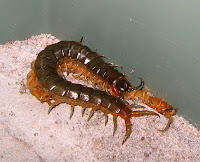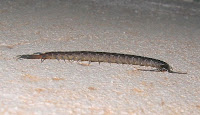Click image to enlarge
Scolopendridae - Cormocephalus sp.
Centipedes in the Scolopendridae family are common and widespread in Australia and include our largest species. They are identified by having 21 pairs of legs and narrow breathing holes (spiracles) along the side of their body, which have adaptations (valves and muscles) permitting them to open and close. This means they are less susceptible to moisture loss and therefore able to live in more arid regions.
As far as I can tell, all the above are the same species, comprising a mixture of immature and adults. The largest one above (around 10 cm or 4” in length) is feeding on a rival and was kindly identified by the Australian Museum as Cormocephalus westwoodi, so presumably so are the others.
They are usually encountered on the ground where commonly found in leaf-litter or under rocks and logs. However around Esperance I often see them 2 or more metres (6’-10’) above the ground on Banksia speciosa flowers, where they generally have their upper parts buried into the flower cluster and their rear end exposed. These flowers are probably a productive nocturnal hunting ground for them, as they attract many insects and spiders they consume.
The centipede is a top predator in the invertebrate world and can grasp prey with all its legs, including the longer ones at the rear, it also has fangs each side of the head that are modified legs but capable of injecting venom. The helpless victim is then torn apart by the mouthparts. Like most centipedes the Scolopendridae have only rudimentary eyesight, so do not run down their prey, but enter burrows or ambush passing invertebrates, although some of the larger species are known to catch and eat vertebrates like small lizards and frogs.





